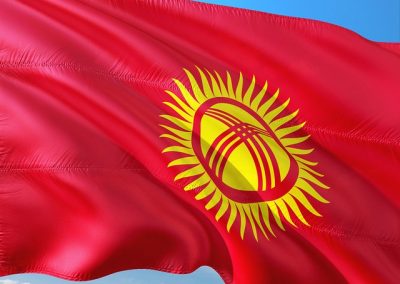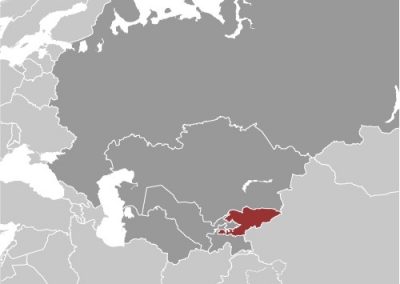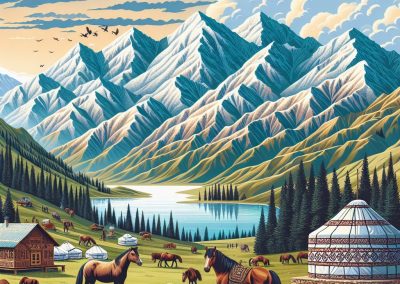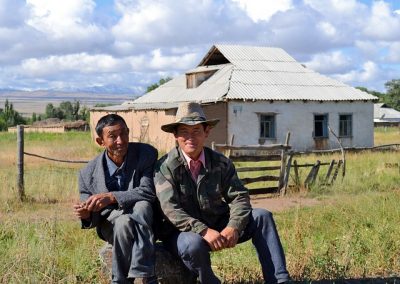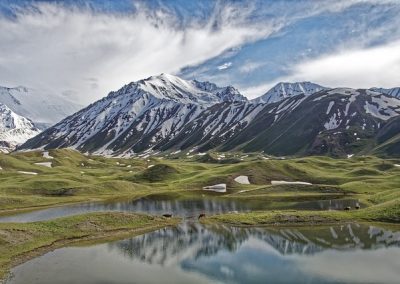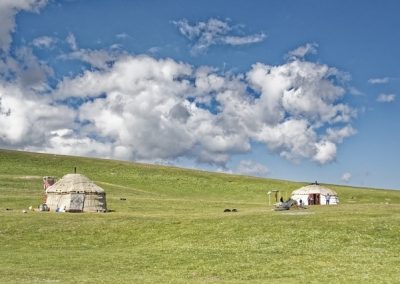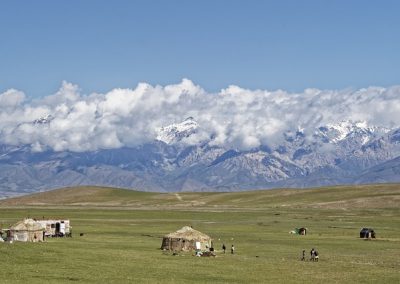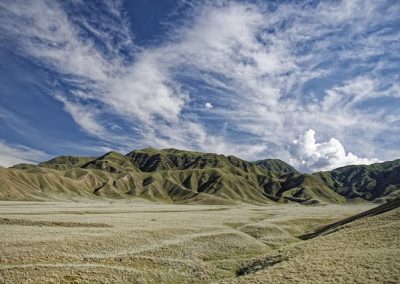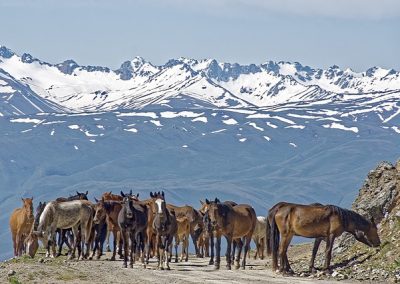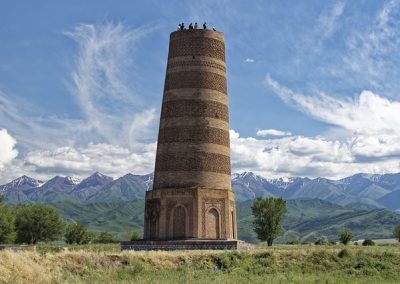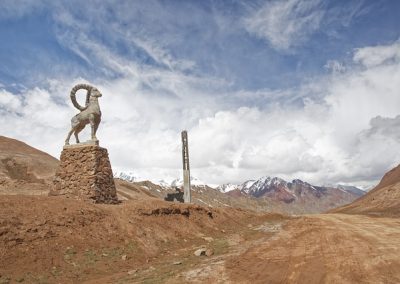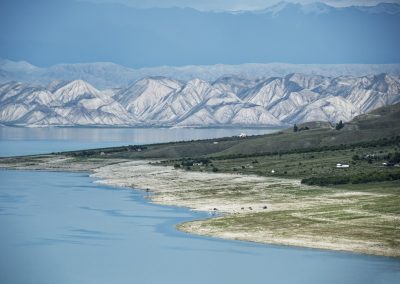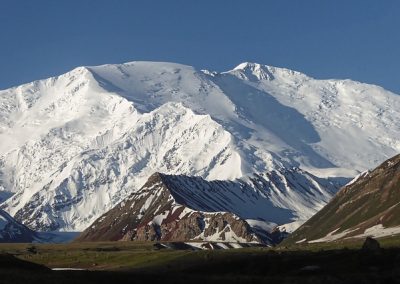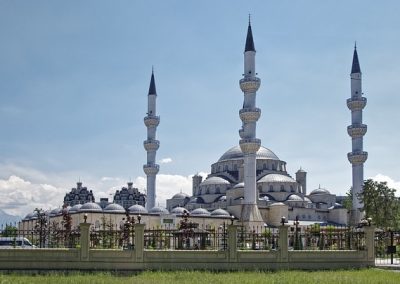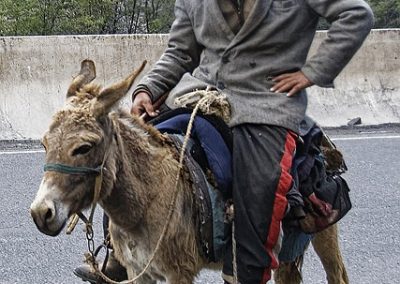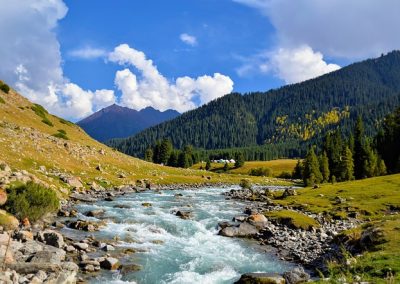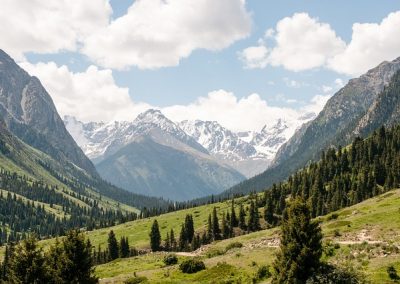Kyrgyzstan (Kyrgyz Respublikasy (Kyrgyz); Respublika Kirgizstan (Russian) (Kyrgyz Republic))

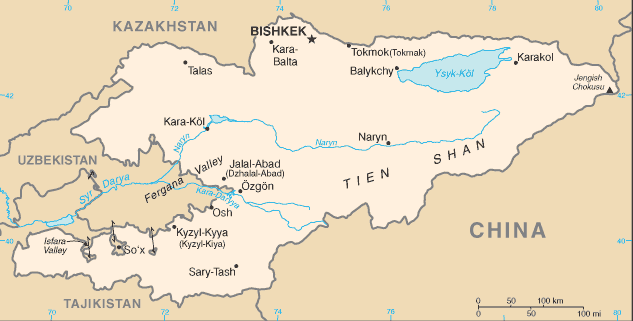
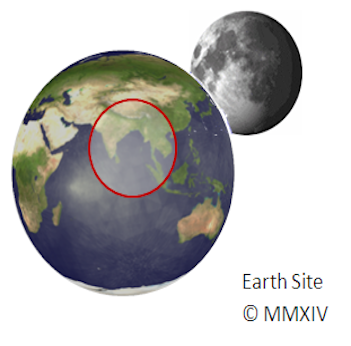
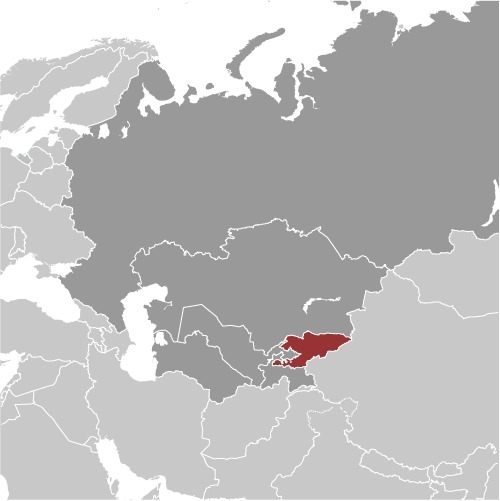
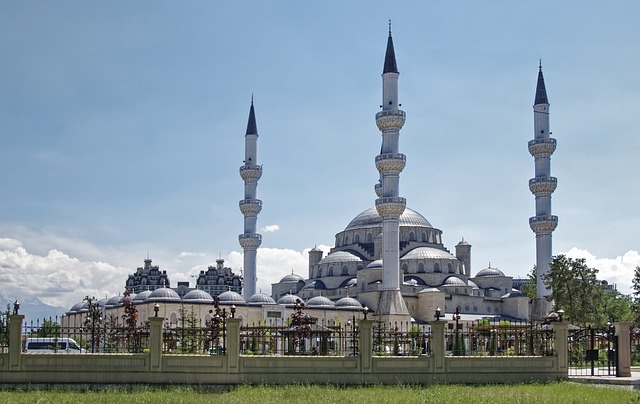
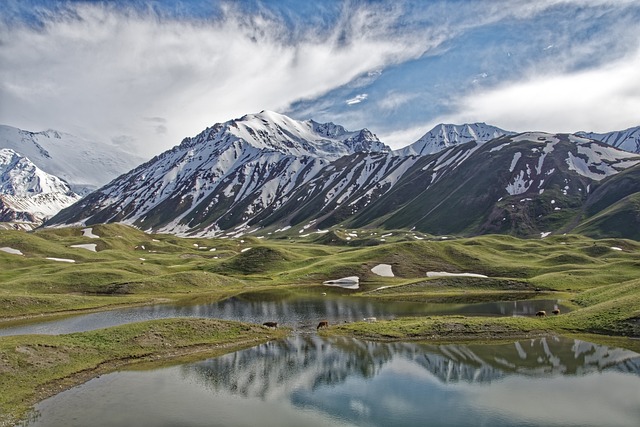
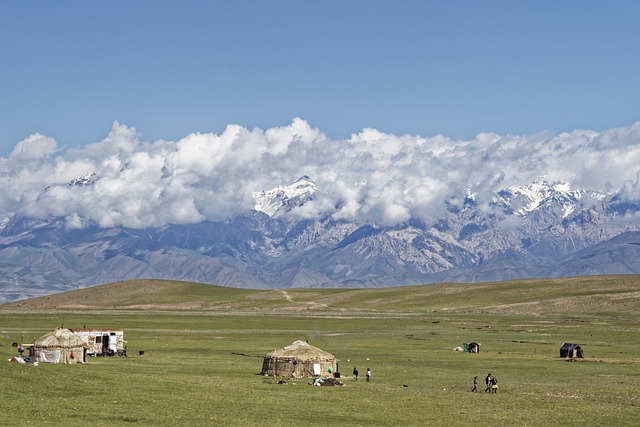
Capital: Bishkek
Population (Estimated July 2012): 5,496,737
Area: 199,945 km2 or 77,199 mi2
Currency: Kyrgyzstan Som (KGS)
Official Language: Kyrgyz; Russian
Political Information: Parliamentary Republic
Official Religion: No Official Religion (approximately 75% of the population are Muslim, 20% are Russian Orthodox and 5% have other religious beliefs).
Highest Mountain: Jengish Chokusu (Victory Peak) at 7,439m or 24,406ft
Largest River:
Time Zone (GMT/UTC): +6:00
Wildlife:
Counties/Provinces/States: 7 provinces (oblastlar, singular – oblasty) and 1 city* (shaar); Batken Oblasty, Bishkek Shaary*, Chuy Oblasty (Bishkek), Jalal-Abad Oblasty, Naryn Oblasty, Osh Oblasty, Talas Oblasty, Ysyk-Kol Oblasty (Karakol)
Leaders: President Almazbek Atambayev, with Prime Minister Omurbek Babanov.
Additional: Gained independence from the Soviet Union on the 31st of August 1991.
Kyrgyzstan
Kyrgyzstan, officially the Kyrgyz Republic, is a landlocked nation situated in Central Asia. It shares borders with Kazakhstan to the north, Uzbekistan to the west, Tajikistan to the south, and China to the east. Bishkek serves as the capital and largest city.
The country boasts a diverse population comprising Kyrgyz, Uzbeks, Russians, and other ethnic groups, each contributing to its rich history and culture. Following its independence from the Soviet Union in 1991, Kyrgyzstan has endeavoured to establish a stable and prosperous nation. The country is renowned for its breathtaking natural landscapes, including majestic mountains, pristine lakes, and verdant valleys.
Kyrgyzstan’s cultural heritage is equally impressive, featuring traditional crafts, music, and cuisine that reflect its multicultural society. Visitors to Kyrgyzstan can partake in a variety of activities, from outdoor pursuits such as trekking and horse riding to exploring ancient historical sites. The warmth and hospitality of the Kyrgyz people further enhance the visitor experience.
With its unique combination of natural splendour and cultural wealth, Kyrgyzstan remains a relatively undiscovered destination with significant tourism potential.
Summary
- Kyrgyzstan is a landlocked country in Central Asia, known for its stunning natural landscapes and rich nomadic heritage.
- The geography of Kyrgyzstan is dominated by mountains, including the Tien Shan range, and the climate varies from subtropical in the Fergana Valley to polar in the high mountains.
- The history of Kyrgyzstan is marked by a mix of nomadic traditions, Soviet influence, and independence since 1991, with a diverse culture influenced by Kyrgyz, Russian, and Uzbek traditions.
- Kyrgyzstan’s economy relies on agriculture, mining, and remittances from Kyrgyz migrants working abroad, with potential for growth in tourism and hydropower industries.
- Tourism in Kyrgyzstan is growing, with attractions including the ancient city of Osh, Lake Issyk-Kul, and opportunities for trekking, horseback riding, and cultural experiences with nomadic communities.
- The political landscape of Kyrgyzstan has been marked by periods of instability and transition, with a parliamentary system and recent protests leading to changes in government.
- The future prospects for Kyrgyzstan include potential for economic development through tourism, hydropower, and regional trade, alongside challenges in political stability and ethnic relations.
Geography and Climate of Kyrgyzstan
Geographical Features
The country is also home to numerous glaciers, lakes, and rivers, including the famous Issyk-Kul Lake, one of the largest alpine lakes in the world.
Outdoor Activities
The diverse geography of Kyrgyzstan offers a wide range of outdoor activities, from trekking and mountaineering to skiing and white-water rafting. The climate in Kyrgyzstan varies depending on the region, with the low-lying Fergana Valley experiencing hot summers and mild winters, while the mountainous areas have a continental climate with cold winters and mild summers.
Natural Beauty and Challenges
The country is also prone to earthquakes and landslides due to its mountainous terrain. Despite these challenges, the natural beauty of Kyrgyzstan continues to attract visitors from around the world, who come to explore its pristine landscapes and experience its unique culture.
History and Culture of Kyrgyzstan
The history of Kyrgyzstan dates back thousands of years, with evidence of human habitation found in the region as far back as the Paleolithic era. Over the centuries, the area that is now Kyrgyzstan has been inhabited by various nomadic tribes and has been part of several empires, including the Mongol Empire and the Russian Empire. In 1936, it became a Soviet republic until gaining independence in 1991.
The culture of Kyrgyzstan is a rich tapestry of traditions, customs, and folklore that have been passed down through generations. The country is known for its traditional crafts such as felt-making, weaving, and pottery, as well as its vibrant music and dance traditions. The Kyrgyz people are also famous for their hospitality and warmth towards guests, with a strong tradition of welcoming visitors into their homes and offering them food and drink.
Economy and Industry in Kyrgyzstan
Kyrgyzstan’s economy is primarily based on agriculture, mining, and services. The country has a diverse agricultural sector that produces crops such as wheat, barley, potatoes, and vegetables. Livestock farming is also an important part of the economy, with sheep, goats, cattle, and horses being raised for meat, dairy products, and wool.
In addition to agriculture, Kyrgyzstan has significant mineral resources, including gold, coal, and uranium. The services sector in Kyrgyzstan has been growing in recent years, with tourism playing an increasingly important role in the economy. The country’s natural beauty and cultural heritage have made it an attractive destination for visitors from around the world.
In addition to tourism, other service industries such as finance, telecommunications, and transportation are also contributing to the country’s economic growth.
Tourism in Kyrgyzstan
Kyrgyzstan’s tourism industry has been growing steadily in recent years, with the country attracting visitors from around the world who come to explore its stunning natural landscapes and experience its unique culture. The country offers a wide range of outdoor activities, from trekking in the Tien Shan mountains to horseback riding in the picturesque valleys. Issyk-Kul Lake is a popular destination for water sports such as swimming, sailing, and fishing.
In addition to its natural beauty, Kyrgyzstan is also home to a number of historical and cultural attractions. The city of Osh is one of the oldest settlements in Central Asia and is known for its ancient bazaar and sacred Sulaiman-Too mountain. The capital city of Bishkek offers visitors a chance to explore Soviet-era architecture, bustling markets, and vibrant nightlife.
With its diverse range of attractions and activities, Kyrgyzstan has something to offer every type of traveller.
Political Landscape of Kyrgyzstan
Challenges Facing the Country
The country has faced challenges related to corruption, ethnic tensions, and economic hardship.
Progress Towards Democracy
However, it has also made progress towards building a more democratic society with greater respect for human rights and freedom of speech.
A Brighter Future Ahead
The political landscape in Kyrgyzstan continues to evolve as the country works towards creating a more stable and prosperous future for its citizens.
Future Prospects for Kyrgyzstan
Despite its challenges, Kyrgyzstan has great potential for growth and development in the coming years. The country’s natural beauty and cultural heritage make it an attractive destination for tourism and investment. With its strategic location in Central Asia, Kyrgyzstan has the opportunity to become a key player in regional trade and cooperation.
The government of Kyrgyzstan has been working on implementing economic reforms to attract foreign investment and create more opportunities for its citizens. In addition to tourism and agriculture, there is potential for growth in industries such as mining, energy, and manufacturing. With continued efforts towards political stability and economic development, Kyrgyzstan has a promising future ahead.
FAQs
What is the capital of Kyrgyzstan?
The capital of Kyrgyzstan is Bishkek.
What is the official language of Kyrgyzstan?
The official language of Kyrgyzstan is Kyrgyz.
What is the currency of Kyrgyzstan?
The currency of Kyrgyzstan is the Kyrgyzstani som.
What is the population of Kyrgyzstan?
As of 2021, the population of Kyrgyzstan is estimated to be around 6.5 million people.
What are the major religions in Kyrgyzstan?
The major religions in Kyrgyzstan are Islam and Russian Orthodox Christianity.
What are some popular tourist attractions in Kyrgyzstan?
Some popular tourist attractions in Kyrgyzstan include Issyk-Kul Lake, Ala Archa National Park, and the Tash Rabat Caravanserai.
What is the climate like in Kyrgyzstan?
Kyrgyzstan has a continental climate, with hot summers and cold winters. The climate varies depending on the region, with the southern part of the country being warmer and drier, while the northern part experiences more extreme temperatures and precipitation.
Natural Resources of Kyrgyzstan: Where Natural Resources are Located in Kyrgyzstan
Kyrgyzstan, a landlocked nation in Central Asia, possesses a diverse array of natural resources. These include mineral deposits, plentiful water resources, fertile agricultural land and extensive forests, all of which play a vital role in the country’s economy...
Political Boundaries of Kyrgyzstan: Provinces, Districts, or Historical Boundaries.
Kyrgyzstan, a landlocked nation in Central Asia, shares borders with Kazakhstan to the north, Uzbekistan to the west, Tajikistan to the south and China to the east. The country’s political boundaries have undergone changes over time, shaped by historical,...
Climate Zones Of Kyrgyzstan: Different Climate Regions Of Kyrgyzstan
Kyrgyzstan, a landlocked nation in Central Asia, is renowned for its diverse climate zones. The country’s landscape is dominated by the Tien Shan mountain range, which contributes to its varied topography. This unique geographical feature has resulted in the...
Terrain and Topography of Kyrgyzstan: mountains, valleys, and plains.
Kyrgyzstan, a landlocked nation in Central Asia, is renowned for its diverse and striking terrain and topography. The country shares borders with Kazakhstan to the north, Uzbekistan to the west, Tajikistan to the south, and China to the east. Kyrgyzstan‘s...
Cultural or Historical Sites of Kyrgyzstan: Important Cultural Landmarks or Historical Sites in Kyrgyzstan
Kyrgyzstan, a landlocked nation situated in Central Asia, boasts a wealth of cultural and historical sites that provide insight into its rich and diverse heritage. The country is home to a wide range of landmarks, spanning from ancient Silk Road caravanserais to...
History of Kyrgyzstan
Kyrgyzstan possesses a rich and diverse history spanning several millennia. The earliest known inhabitants of the region were the Scythians, a nomadic people who traversed the Eurasian steppes circa 800 BCE. The Kyrgyz people, who constitute the primary ethnic group...
Population Density of Kyrgyzstan
Kyrgyzstan, a landlocked nation in Central Asia, is renowned for its remarkable natural landscapes, including the Tien Shan mountain range and Lake Issyk-Kul. With a population of approximately 6.5 million inhabitants, Kyrgyzstan boasts a diverse populace and a rich...
